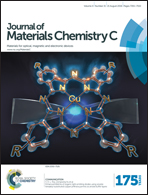Influence of praseodymium content and postdeposition annealing on the structural and sensing characteristics of PrTixOy sensing films using the sol–gel spin-coating method†
Abstract
In this paper, we developed a low-cost, simple and rapid fabrication method for a PrTixOy electrolyte–insulator–semiconductor (EIS) sensor using the sol–gel spin-coating technique. The influence of praseodymium content and postdeposition annealing on the structural and sensing properties of PrTixOy sensing membranes was investigated. X-ray diffraction, atomic force microscopy, and X-ray photoelectron spectroscopy were used to investigate the structural, morphological and chemical features of these films, respectively, as functions of the growth conditions (Pr concentrations ranging from 0.1 to 0.3 M; temperatures ranging from 700 to 900 °C). The observed structural properties were then correlated with the resulting pH sensing performances. The PrTixOy EIS device prepared under a Pr concentration of 0.2 M, with subsequent annealing at 800 °C, exhibited the best sensing characteristics, including pH sensitivity, hysteresis and drift. We attribute this behaviour to the optimal praseodymium content and annealing temperature in this sensing film forming a well-crystallized Pr2TiO5 structure and a rougher surface.


 Please wait while we load your content...
Please wait while we load your content...